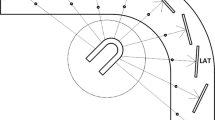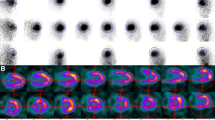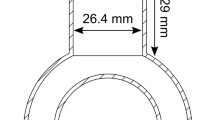Abstract
Background
Due to differences in the design and acquisition parameters on the solid-state CZT cardiac camera the effect of patient motion may vary compared to Anger cameras. This study evaluates the effect of motion, two new methods of three-dimensional (3D) motion detection and a method of motion correction.
Method
Phantom acquisitions were offset in the X, Y, and Z directions and combined to simulate different types of motion. Motion artifacts were identified using the total perfusion defect and blinded visual interpretation. Motion was detected by registering planar and reconstructed 30 second images, and corrected by summing the aligned reconstructed images. Validation was performed on phantom data. These techniques were then applied to 40 patient studies.
Results
Motion ≥10 mm and ≥60 seconds in duration introduced significant artifacts. There was no significant difference (P = .258) between the two methods of motion detection. Motion correction removed artifacts from 9/10 phantom simulations. Superior-inferior motion ≥8 mm was measured on 10% of patient studies, and 5% were affected by motion. Motion in the lateral and anterior-posterior directions was <8 mm.
Conclusion
Superior-inferior patient motion artifacts have been identified on myocardial perfusion images acquired on a CZT camera. Routine QC to identify studies with significant motion is recommended.







Similar content being viewed by others
Abbreviations
- CZT:
-
Cadmium-zinc-telluride
- TPD:
-
Total perfusion defect
- MPI:
-
Myocardial perfusion imaging
- QFOV:
-
Quality field of view
- ShIRT:
-
Sheffield image registration toolkit
- Tc99m :
-
Technetium-99m
- EANM:
-
European Association of Nuclear Medicine
- SNM:
-
Society of Nuclear Medicine
- QPS:
-
Quantitative perfusion SPECT
- MIBI:
-
Methoxyisobutylisonitrile
- CAD:
-
Coronary artery disease
References
Botvinick EH, Zhu YY, O’Connell WJ, Dae MW. A quantitative assessment of patient motion and its effect on myocardial perfusion SPECT images. J Nucl Med 1993;34:303-10.
Sorrell V, Figueroa B, Hansen CL. The “hurricane sign”: Evidence of patient motion artifact on cardiac single-photon emission computed tomographic imaging. J Nucl Cardiol 1996;3:86-8.
Cooper JA, Neumann PH, McCandless BK. Effect of patient motion on tomographic myocardial perfusion imaging. J Nucl Med 1992;33:1566–71.
Friedman J, Van Train K, Maddahi J, Rozanski A, Prigent F, Bietendorf J, et al. “Upward creep” of the heart: A frequent source of false-positive reversible defects during thallium-201 stress-redistribution SPECT. J Nucl Med 1989;30:1718-22.
Matsumoto N, Berman DS, Kavanagh PB, Gerlach J, Hayes SW, Lewin HC, et al. Quantitative assessment of motion artifacts and validation of a new motion-correction program for myocardial perfusion SPECT. J Nucl Med 2001;42:687-94.
Hesse B, Tagil K, Cuocolo A, Anagnostopoulos C, Bardies M, Bax J, et al. EANM/ESC procedural guidelines for myocardial perfusion imaging in nuclear cardiology. Eur J Nucl Med Mol Imaging 2005;32:855-97.
Strauss HW, Miller DD, Wittry MD, Cerqueira MD, Garcia EV, Iskandrian AS, et al. Procedure guideline for myocardial perfusion imaging 3.3. J Nucl Med Technol 2008;36:155-61.
Fitzgerald J, Danias P. Effect of motion on cardiac SPECT imaging: Recognition and motion correction. J Nucl Cardiol 2001;8:701-6.
Volokh L, Lahat C, Binyamin E, Blevis I. Myocardial perfusion imaging with an ultra-fast cardiac SPECT camera—A phantom study. Nuclear Science Symposium Conference Record. Dresden: IEEE; 2008. p. 4636-9.
Esteves FP, Raggi P, Folks RD, Keidar Z, Askew JW, Rispler S, et al. Novel solid-state-detector dedicated cardiac camera for fast myocardial perfusion imaging: Multicenter comparison with standard dual detector cameras. J Nucl Cardiol 2009;16:927-34.
Buechel R, Herzog B, Husmann L, Burger I, Pazhenkottil A, Treyer V, et al. Ultrafast nuclear myocardial perfusion imaging on a new gamma camera with semiconductor detector technique: First clinical validation. Eur J Nucl Med Mol Imaging 2010;37:773-8.
Bocher M, Blevis IM, Tsukerman L, Shrem Y, Kovalski G, Volokh L. A fast cardiac gamma camera with dynamic SPECT capabilities: Design, system validation and future potential. Eur J Nucl Med Mol Imaging 2010;37:1887-902.
Herzog BA, Buechel RR, Katz R, Brueckner M, Husmann L, Burger IA, et al. Nuclear myocardial perfusion imaging with a cadmium-zinc-telluride detector technique: Optimized protocol for scan time reduction. J Nucl Med 2010;51:46-51.
Schillaci O, Danieli R. Dedicated cardiac cameras: A new option for nuclear myocardial perfusion imaging. Eur J Nucl Med Mol Imaging 2010;37:1706-9.
Garcia EV, Faber TL, Esteves FP. Cardiac dedicated ultrafast SPECT cameras: New designs and clinical implications. J Nucl Med 2011;52:210-7.
Duvall W, Croft L, Ginsberg E, Einstein A, Guma K, George T, et al. Reduced isotope dose and imaging time with a high-efficiency CZT SPECT camera. J Nucl Cardiol 2011;18:847-57.
Barber DC, Hose DR. Automatic segmentation of medical images using image registration: Diagnostic and simulation applications. J Med Eng Technol 2005;29:53-63.
Barber DC, Oubel E, Frangi AF, Hose DR. Efficient computational fluid dynamics mesh generation by image registration. Med Image Anal 2007;11:648-62.
Slomka P, Nishina H, Berman D, Akincioglu C, Abidov A, Friedman J, et al. Automated quantification of myocardial perfusion SPECT using simplified normal limits. J Nucl Cardiol 2005;12:66-77.
Cerqueira MD, Weissman NJ, Dilsizian V, Jacobs AK, Kaul S, Laskey WK, et al. Standardized myocardial segmentation and nomenclature for tomographic imaging of the heart. Circulation 2002;105:539-42.
Kapur A, Latus K, Davies G, Dhawan R, Eastick S, Jarritt P, et al. A comparison of three radionuclide myocardial perfusion tracers in clinical practice: The ROBUST study. Eur J Nucl Med Mol Imaging 2002;29:1608-16.
Hindorf C, Oddstig J, Hedeer F, Hansson M, Jögi J, Engblom H. Importance of correct patient positioning in myocardial perfusion SPECT when using a CZT camera. J Nucl Cardiol 2014;21:695-702.
Karacalioglu AO, Jata B, Kilic S, Arslan N, Ilgan S, Ozguven MA. A physiologic approach to decreasing upward creep of the heart during myocardial perfusion imaging. J Nucl Med Technol 2006;34:215-9.
Prigent FM, Hyun M, Berman DS, Rozanski A. Effect of motion on thallium-201 SPECT studies: A simulation and clinical study. J Nucl Med 1993;34:1845-50.
Acknowledgments
This article is independent research arising from a NIHR/CSO Healthcare Scientist Doctoral Research Fellowship supported by the National Institute for Health Research. The views expressed in this publication are those of the author(s) and not necessarily those of the NHS, the National Institute for Health Research or the Department of Health.
Disclosures
S. Redgate reports funding received under a NIHR/CSO Healthcare Scientist Doctoral Research Fellowship supported by the National Institute for Health Research, in relation to this study. Dr Al-Mohammad reports other support from Servier, outside the submitted work. Prof. Tindale reports funding from the National Institute for Health Research, in her capacity as a Director of NIHR Devices for Dignity Healthcare Technology Co-operative, outside the submitted work. Prof Barber, Dr Fenner, Mr Taylor, and Mr Hanney, have nothing to disclose.
Author information
Authors and Affiliations
Corresponding author
Additional information
See related editorial, doi:10.1007/s12350-015-0321-2.
Rights and permissions
About this article
Cite this article
Redgate, S., Barber, D.C., Fenner, J.W. et al. A study to quantify the effect of patient motion and develop methods to detect and correct for motion during myocardial perfusion imaging on a CZT solid-state dedicated cardiac camera. J. Nucl. Cardiol. 23, 514–526 (2016). https://doi.org/10.1007/s12350-015-0314-1
Received:
Accepted:
Published:
Issue Date:
DOI: https://doi.org/10.1007/s12350-015-0314-1




